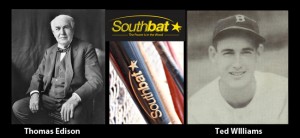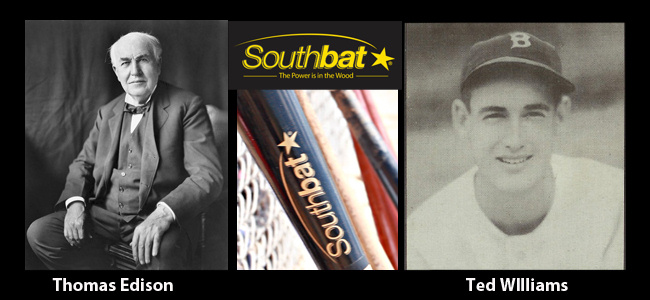Sinc e the introduction of aluminum bats in the 1970s, there has been an on-going debate about the advantages of metal over wood bats. In this two part series, I’m going to look at the debate through the eyes of both Thomas Edison, one of the greatest inventor of all times, and those of Ted Williams, one of the greatest hitters of all times. These articles are also being featured on Southbat USA’s media. Southbat is a company manufacturing bats out of Guayaibi wood. You can find more information at the bottom of this article about their company and bats. The opinions contained in these articles are my own and I have not been compensated by Southbat in any way for writing them.
e the introduction of aluminum bats in the 1970s, there has been an on-going debate about the advantages of metal over wood bats. In this two part series, I’m going to look at the debate through the eyes of both Thomas Edison, one of the greatest inventor of all times, and those of Ted Williams, one of the greatest hitters of all times. These articles are also being featured on Southbat USA’s media. Southbat is a company manufacturing bats out of Guayaibi wood. You can find more information at the bottom of this article about their company and bats. The opinions contained in these articles are my own and I have not been compensated by Southbat in any way for writing them.
Thomas Edison
While Thomas Edison probably never played baseball, he probably would have understood what it took to be a great baseball player. He was a prolific inventor and filed 1,093 US patents over his lifetime, an individual record that still stands today. Thomas Edison is the all-time “home run” leader when it comes to inventions.
Like all good baseball hitters, Thomas Edison had to deal with his fair share of failure. But Edison could have never played major league baseball with his batting average in producing inventions. In order to get an accurate read of Edison’s “batting average,” we would have to know the total number of experiments behind the 1,093 patents. Although that number is beyond the scope of this article, if we use just his fifty-thousand experiments for the development of a storage battery as “at-bats,” and if we viewed the storage patents awarded to him as “hits” (he achieved 141 patents related to his storage battery), you can see that Edison’s batting average was probably quite low. In the case of the storage battery, he batted .013.
While you might think that Edison would be discouraged with such a low batting average, he maintained a positive attitude towards his work. Walter Mallory, a long-time associate of Edison, once lamented to Edison about the lack of success in the storage battery experiments and said: “Isn’t it a shame that with the tremendous amount of work you have done you haven’t been able to get any results?” Edison is said to have replied: “Results! Why, man, I have gotten a lot of results! I know several thousand things that won’t work.” With a lot of persistence, Edison eventually developed his storage battery.
Ted Williams
Ted Williams, one of the best baseball hitters of all times, was once quoted as saying that “baseball is the only field of endeavor where a man can succeed three times out of ten and still be considered a good performer.” Evidently, Ted Williams never considered Edison’s “field of endeavor.” But Williams, who authored The Science of Hitting, was no slouch when it came to baseball, experimentation and even science. He approached hitting like a lifelong research project. He studied the swing, he practiced it incessantly and he studied pitchers through a microscope. In his book, he claimed that he could recount the exact at-bats for his first thirty career home runs—who the pitcher was, the count, the pitch itself. While Edison kept thousands of notebooks detailing his experiments, Williams said he didn’t have to keep a book on pitchers because he said “he lived a book on pitchers.” He described every trip to the plate he made (almost eight thousand) as an “adventure” that give him information he could use later. He had an incredible memory.
Edison and Williams
Edison didn’t have much time for sports when he was young. His mother pulled him out of school when he was age seven after his teacher described his thinking process as “addled” or scrambled to Edison’s mother. She knew differently and so she decided to home school him. Edison’s spare time was spent in the cellar of their home, and later in a baggage car of a train, running experiments in makeshift labs.
Williams’ parents both had full time careers and their absence at home provided him with ample time to devote to the game of baseball. He ran his experiments out in the sandlots around San Diego. Like Edison, he wasn’t much for school. He simply didn’t like it, except for history. According to Williams, for the first twenty years of his life all he did was practice and play baseball.
While Williams always wanted to be the best hitter in baseball of all times, it is unclear if Edison wanted to be the best inventor in history. Edison seemed to develop his goal with each passing day and each passing experiment. After all, there was no model for him to follow in becoming a great inventor on his own. His legacy is that he created the model for a successful research and development program that is emulated to this day. In a sense, he created his own teams of inventors that competed against one another in the confines of his West Orange, New Jersey facility which is now part of Thomas Edison National Historical Park. (I highly recommend visiting the lab complex there that reopened in 2009 after being closed due to renovation for six years.)
Ted Williams and Thomas Edison did have different personalities for sure. When Edison got angry, he was said to write a letter to himself and then tear it up a few days later. Ted Williams, on the other hand, had a short fuse and would lose his temper. Though they differed, they shared much in common in how they approached their work. Both lives were marked for an unwavering passion—some may say an obsession—to pursue their fields of endeavor. Both men made it a business to learn by their mistakes or experiences quickly and to use that information in taking their work to a higher level.
Next week, I’ll look at what Edison and Williams might think of the great debate over wood versus metal bats after the adoption of the BBCOR standard.
Resources:


Here’s one three part DM I received:
“I believe there is only one difference between wood and metal and that is I believe hitters have a more natural swing with wood.Obviously if you hit the sweet spot with either bat it will travel but with wood you have to hit the sweet spot every time.Hitters understand this and that’s why I believe hitters have a smoother, more natural swing with wood.”
Here is another multi-part DMI received via twitter:
“I play in a wood bat conference and I love pitching against it..metal isn’t traditional an makes bad hitters look good. Hitters in high school look good with metal but can’t hit with wood..it proves an actual good hitter.I throw a split change and it allows. Ground ball after ground ball..with metal you can slap it over a inf head..it’s a different game. We play wood in our conference but when we travel other teams use metal and we use wood..we have to win games using small ball and execution.”
Here is another multi-part DMI received via twitter: “I play in a wood bat conference and I love pitching against it. Metal isn’t traditional and makes bad hitters look good. Hitters in high school look good with metal but can’t hit with wood. Wood proves an actual good hitter. I throw a split change and it allows ground ball after ground ball. With metal you can slap it over a inf head. It’s a different game. We play wood in our conference but when we travel other teams use metal and we use wood. We have to win games using small… Read more »
Here is another DM:
“To me i think there is a difference. With the new bbcor bats, pitchers have such an advantage. You dont get that carry on the ball that as a hitter you used to have. Wood bats probably have more pop and torque than the new metal bats we are required to use.”
Here is another DM via twitter:
“Depends on what type of metal. The only BESR bats had a lot more pop off of them but now that we are using BBCOR bats I believe there is much more pop off of a wooden bat. I would much rather use a wooden bat than BBCOR any day.”
Here is another DM via twitter:
“Hello Mr. Swyers, There is a big difference in the speed of the ball coming off the bat. Colleges should stay with BBCOR and not go to wood.”
Another DM via twitter:
“Yeah, the wood is always good. The aluminum bats hit farther, but the new bbcore bats suck.”
Another series of DMs via twitter ” Hi. Nice to meet you also. Yes I have used both over many years. People have all different opinions, but I think wood is better.Wood allows you to have solid contact or an out. You must hit the ball solid for a good hit, where with metal you may get lucky I believe metal is great until kids are older because then you can get hurt much easier and get cheap hits/home runs.With wood you must use all your muscles and have a solid swing to hit big hits. Even if your roll your… Read more »
[…] is the second installment of a two part article. The first part was published last week at this link) The Connected Lives of Thomas Edison and Ted […]